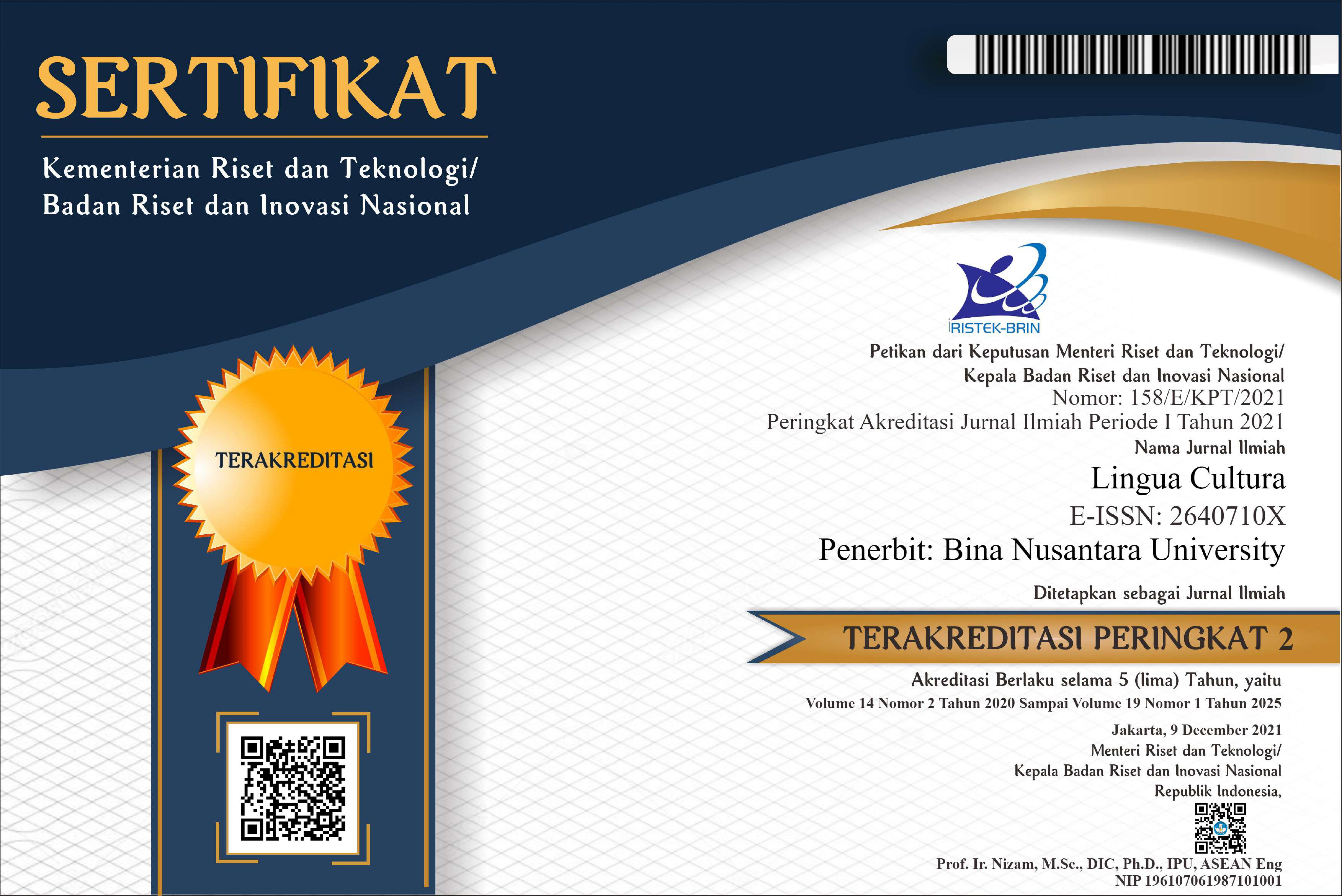The Study of Figurative Languages using Stylistics Theory in What My Mother Doesn’t Know by Sonya Sones
DOI:
https://doi.org/10.21512/lc.v2i2.307Keywords:
novel-in-verse, stylistics, figurative languageAbstract
What My Mother Doesn’t Know is a novel-in-verse by Sonya Sones which tells about a teenage girl named Sophie who tries to find her Mr. Right and her bad relationship with her parents. In the end, Sophie finds her Mr. Right who is actually not her type of boy friend but he can make her feel happy and even though she hates her parents, she realizes that she loves them nevertheless. The purpose of this article is to prove that the author’s use of style can reveal the themes of novel-in-verse The analysis of the novel-in-verse focuses mainly on the themes and the figurative language of simile, metaphor, personification, paradox, and hyperbole. Research methods are conducted in qualitative method in the form of library research and statistics to calculate how many poems use the five figurative languages and are related to the themes. In the analysis, the author’s style is figurative language and there are three themes that can be taken from the novel-in-verse. The themes are overwhelmed feeling does not show the true feeling, the bond of family will always be there, no matter how hateful we are to them and love is not determined by someone’s physical appearance. The result shows that 91.36 percents of poems that use the five figurative languages are related to the themes. It can be concluded that the author’s style in writing the novel-in-verse can reveal the three themes.Plum Analytics
References
Arp, T. R. 1984. Perrine’s Sound and Sense: An Introduction to Poetry. Orlando: Harcourt Brace & Company.
Arp, T. R., & Johnson, G. 1959. Perrine’s story and structure. Boston: Thomson Higher Education.
“All American: Glossary of Literary Terms”. Retrieved March 28, 2008, website:
http://www.uncp.edu/home/canada/work/allam/general/glossary.htm
Barnet, S., Burto, W., & Cain, E. W. 2005. Literature for Composition: Essays, Fiction, Poetry, and Drama. New York: Pearson Longman
Barry, P. 1995. Beginning Theory. Manchester: Manchester University Press
Bradford, R. 1997. Stylistics. London: Rout ledge.
Gill, R. 1995. Mastering English Literature. New York: Palgrave.
Kennedy, X. J. 1979. Literature: An Introduction to Fiction, Poetry, and Drama. Canada: Little, Brown & Company.
Kennedy, X. J., & Gioia, D. 2005. Literature: An Introduction to Fiction, Poetry, and Drama. New York: Pearson Longman
Leech, G. N. 1969. A Linguistic Guide to English Poetry. England: Pearson Education Limited.
Leech, G. N., & Short, M. H. 1981. Style in Fiction: A Linguistic Introduction to English Fictional Prose. London and New York: Longman.
“Literary Terms”. Retrieved March 28, 2008 website:
http://academic.brooklyn.cuny.edu/english/melani/lit_term.html
McArthur, T. 1992. The Oxford Companion to the English Language. Oxford: OUP.
Smith, V. “What Is Poetry?” Retrieved September 25, 2007, from Gallaudet University website: http://depts.gallaudet.edu/englishworks/literature/poetry.html#basic
Talib, I. S. “A Brief List of Some Key Terms in Literature.” Retrieved March 17, 2008, from School zone website: http://courses.nus.edu.sg/COURSE/ELLIBST/lsl01-tm.html
Taylor, R. 1981. Understanding the Elements of Literature: It’s Forms, Techniques and Cultural Conventions. New York: St. Martin’s Press, Inc.
Wales, K. 2001. A Dictionary of Stylistics. England: Harlow
Downloads
Published
Issue
Section
License
Authors who publish with this journal agree to the following terms:
a. Authors retain copyright and grant the journal right of first publication with the work simultaneously licensed under a Creative Commons Attribution License - Share Alike that allows others to share the work with an acknowledgment of the work's authorship and initial publication in this journal.
b. Authors are able to enter into separate, additional contractual arrangements for the non-exclusive distribution of the journal's published version of the work (e.g., post it to an institutional repository or publish it in a book), with an acknowledgment of its initial publication in this journal.
c. Authors are permitted and encouraged to post their work online (e.g., in institutional repositories or on their website) prior to and during the submission process, as it can lead to productive exchanges, as well as earlier and greater citation of published work.
USER RIGHTS
All articles published Open Access will be immediately and permanently free for everyone to read and download. We are continuously working with our author communities to select the best choice of license options, currently being defined for this journal as follows: Creative Commons Attribution-Share Alike (CC BY-SA)

















